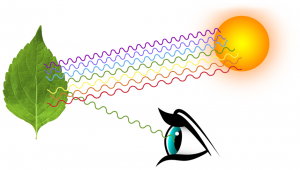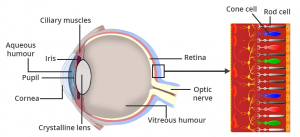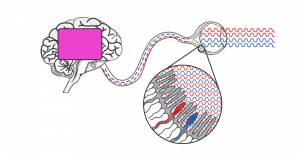What are colours and how do we see them?
 We associate objects with their colours. When you
hear the word “chillies”, you will most probably think of either green or
red.
We associate objects with their colours. When you
hear the word “chillies”, you will most probably think of either green or
red.
But do objects have colours? If you show a ripe tomato to a person who is colourblind to ‘red’ and ask the colour, the answer you get will definitely not be red.
So what are colours? Colours are our brain’s way of interpreting the wavelengths of light. The light that the human eyes can detect is called the visible light. It is a collection of radiations with different wavelengths which is part of the electromagnetic spectrum.

Each radiation has its own wavelength and our brain has a mechanism that helps us perceive these radiations as colours. Many of us are fortunate enough to perceive all the colours in the visible light range of the electromagnetic spectrum.

When light falls on an object, it absorbs radiations with certain wavelengths and reflects the rest. What we see are the reflected rays. Let us take a green leaf for example. The leaf absorbs all radiations except the green light (wavelength ~ 560–520 nm). When this light falls on the eyes, electrical impulses are generated and sent to our brain which creates the aspect of colour.

Human eyes have two types of light-sensitive cells; rods and cones present behind the retina of the eye. The rods help us see in dim light and the signals sent by these cells are interpreted by the brain depending on the intensity of light. That is, only the brightness of the surroundings can be perceived by the rods. Cones, on the other hand, are the colour perceiving cells. There are three types of cones which are sensitive to three different colours – blue (shorter-wavelengths), green (medium-wavelengths), and red (longer-wavelengths).
When blue light falls on the eye, the cones that are sensitive to the shorter wavelengths send signals to the brain and we see the object from which the light is coming as blue in colour. The same is true for red and green colours.
 But what about other colours,
say yellow? Let us consider a scenario where an object is reflecting the
yellow light. Human eyes do not have cones sensitive to yellow wavelength.
But, the yellow light is close to both green and red wavelengths. Thus, the
cones sensitive to both green and red wavelengths send signals to the brain
where it interprets the colour.
But what about other colours,
say yellow? Let us consider a scenario where an object is reflecting the
yellow light. Human eyes do not have cones sensitive to yellow wavelength.
But, the yellow light is close to both green and red wavelengths. Thus, the
cones sensitive to both green and red wavelengths send signals to the brain
where it interprets the colour.

Another scenario is when an object is emitting/reflecting both blue and red light with equal intensity. In this case, both blue and red cones get activated and the brain perceives the object to be magenta in colour.
Some organisms such as birds, reindeers can perceive ultraviolet light. Can you
imagine how different the world looks to them than it does to us humans? While
you are at it, think of a few more aspects related to light and colours such as
– why do objects or surfaces emit, absorb, or reflect a certain colour of
light? How do some organisms see at night? Visit our website to get more updates
on the same.
– Beena P V
